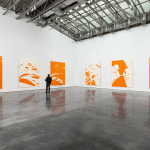
Contributed by Jacob Patrick Brooks / The lofts of downtown New York occupy a special place in American art history. They functioned most importantly as incubators for Abstract Expressionism in the 1950s, eventually giving way to the galleries of the 1980s and 1990s. Today, the spaces once occupied by Barbara Gladstone, Pat Hearn, and Willem de Kooning have been replaced with Uniqlo, Nike, and expansive apartments for the super wealthy. In “Wave Pattern,” a downtown apartment show on the sixth floor of an unassuming Broadway building, art world scions Dylan Brant and Max Werner provide some relief from this cluttered, big-box nightmare.

What sets the show apart from other DIY efforts is the glimpse it provides into the imaginations of collectors. We see the results of the twentieth century’s worst behavior in the living space of the rich, rather than work heavily influenced by that behavior in the living room of a Bushwick hipster. You walk in and are greeted by a large Schnabel in an ornate gold frame. To its immediate left are two more prints of his. On your right, there’s a David Salle painting, on the wall to your left a Keith Haring drawing. Turn the corner and you’re greeted by a Cady Noland. It’s truly a star-studded show, so I don’t care that the Kippenberger next to the Schnabel (effectively containing him at the entrance) is under a beam with no direct light. I also don’t care that when I turn the corner the guestbook is brighter than the Charline von Heyl to its right. Seeing the work seems less important than knowing that the person who made it is important. Why else would it be in a room this nice?



Once I calmed down, I focused first on Noland’s work Untitled. She has recently re-emerged with her first solo show in roughly 20 years, at Gagosian, having spent much of the intervening time in a combative frame of mind about the reception of her work. The piece on view here is a quadruple silkscreen portrait of William Randolph Hearst. Only one face is fully visible, but all are black and white. The three remaining faces are blown out or obscured by the only color in the polished steel frame: a streak of red-orange ink. It’s unclear whether Noland is making a point about how information is spread unevenly depending on who owns the means of distribution (newspapers for Hearst, screenprints for Noland) or if she’s just following an artistic impulse to be funny and difficult. Either way, it’s effective. Interestingly, the print appears to be hung at 56 to 60 inches. In images I’ve seen of this piece elsewhere, however, it has been on the ground leaning against a wall. The curators’ apparent decision to display the work differently than originally intended raises questions about how much the artists knew about their participation in the show, and whether some might have been surprised.

Deeper in the space, the work has more room to breathe and more light in which to be seen. There’s a black-and-white Warhol drawing of a fragment of a Jeep ad framed between two windows, forming a sort of triptych. To its left is Josh Smith’s Untitled from 2019. The image is of several fish that fit together like puzzle pieces, composed of cool blues and greens punctuated with red stripes. The picture is enclosed in a bright, snot-green border that’s interrupted with red dots. At least from a distance, it feels more about line and drawing than anything else. You can’t get close because it’s hung on the other side of a staircase railing, which in turn is blocked with a sign that says “private,” tilted slightly down as if to avoid eye contact. You may be a guest in a living space, but there are still boundaries.



The show is more profound than a mere opportunity to see a von Heyl and a Kippenberger in the same room. Yes, the lineup is a safe bet, guaranteed to please everyone from shallow students of recent art history to those who experienced the excess and instability that encouraged the work. It’s also a peek into the minds and impulses of collectors and the well-connected, suggesting how a Met wall plaque 200 years from now might describe the upper crust of the early twenty-first century: what their lives were like, how they had great taste as well as money, the way they tolerated and even enjoyed iconoclastic breaks in the prevailing aesthetic. Most importantly, though, “Wave Pattern” exposes our visceral present and how art is converted from radical statements to displays of wealth and class. Beyond that, what superficially looks like little more than a crowd-pleasing show prompts uncomfortable questions about this moment. As more galleries close and the art world downsizes in response to the disappearance of easy money, what will innovation look like, who will the innovators be, and who will embrace them?
“Wave Pattern,” presented by Dylan Brant and Max Werner, 575 Broadway, Floor 6, New York, NY. Through Dec 1, 2023.
About the author: Jacob Patrick Brooks is a Brooklyn painter who grew up in Kansas.
NOTE: The Two Coats of Paint 2023 Year-end Fundraising Campaign is underway, and our goal this year is to reach 100% reader participation. If you enjoy the artist interviews, exhibition reviews, NYC and HV Selected Gallery Guides, and other Two Coats painting-cenric content, this is your opportunity to be a part of it. Please consider making a tax deductible contribution to support the project in 2024. Thank you for all your help keeping the conversation going.























Hard to stomach such “safe bet” curation by such obnoxiously privileged personalities. Despite whatever value there may be in putting these works and artists in the same room, it doesn’t seem like this show is deserving of much more than an eye roll.